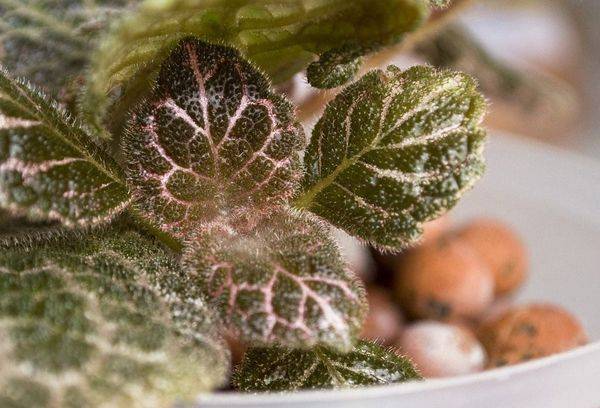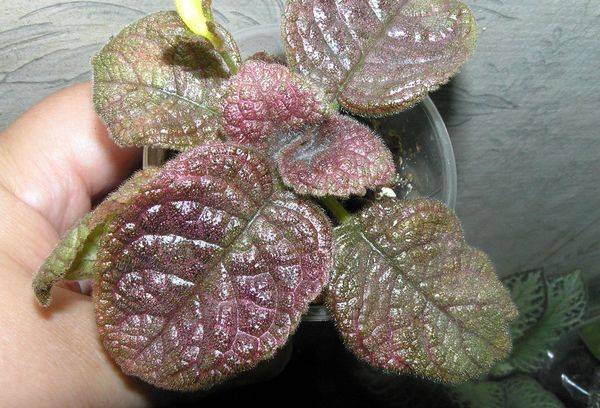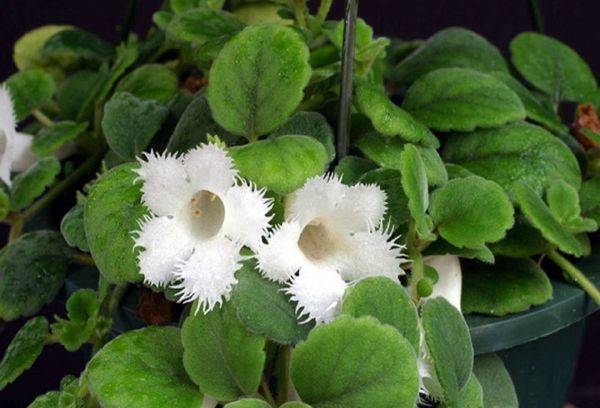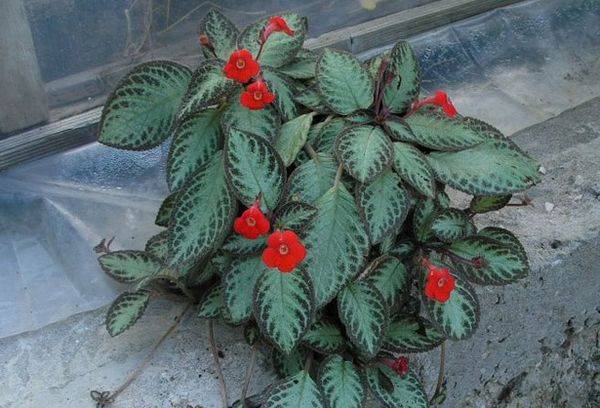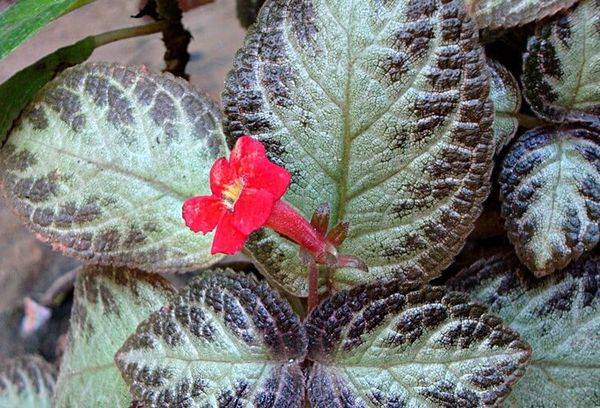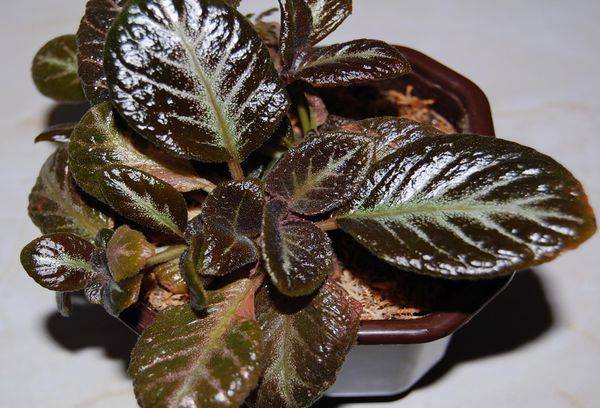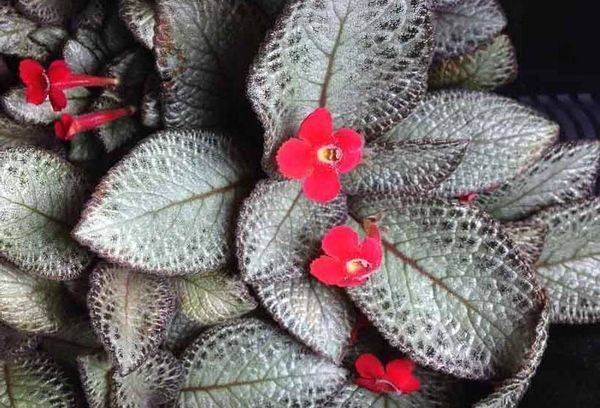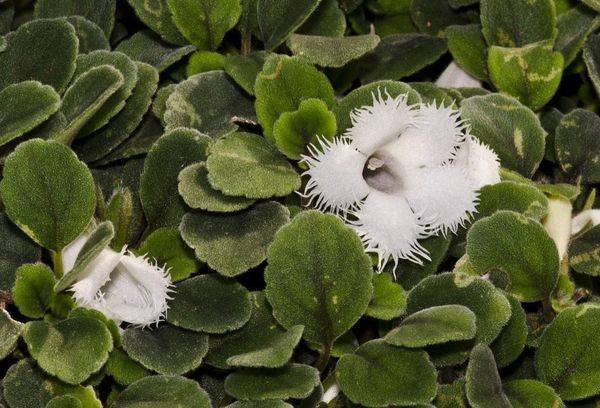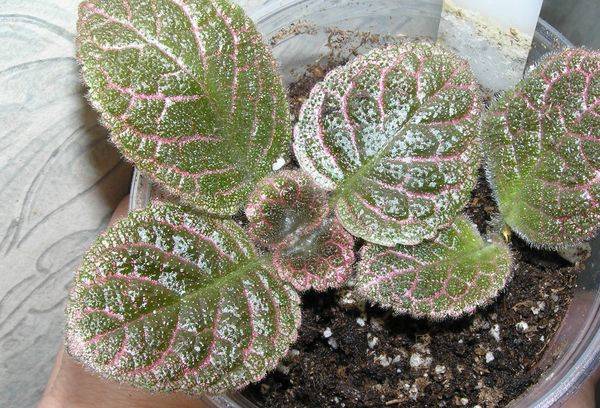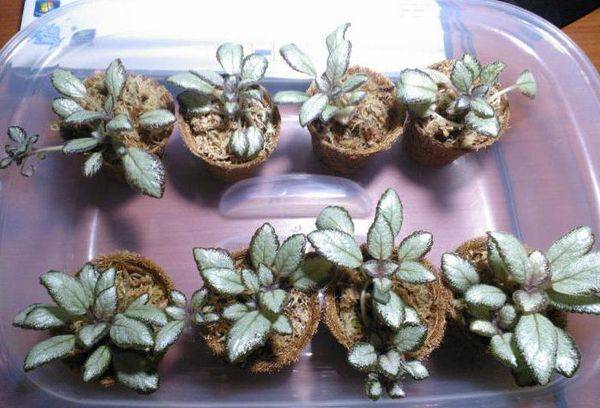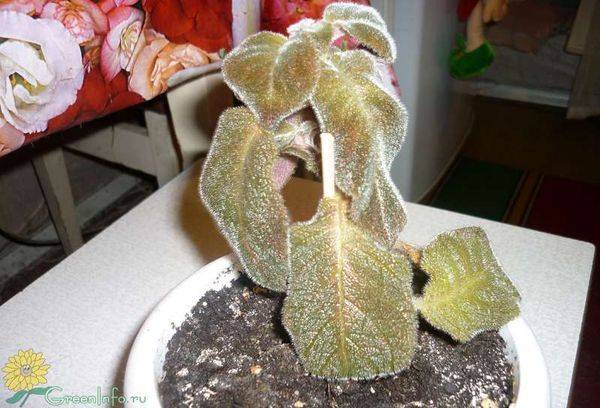How to properly care for a graceful description
Content:
How did gardeners love the description? This plant retains decorative properties throughout the year: graceful flowers and no less graceful rounded leaves, decorated with a colorful pattern. Caring for an episode is not a problem, but a pleasure.
Description
Episcia is an herbaceous perennial from the Gesneriaceae family. In the wild, it develops as a short, creeping grass; in indoor conditions it is grown as an ampelous plant. The birthplace of the flower is the tropics of Central and South America: the dark and moist forests of Mexico, Colombia, Brazil, the Antilles and Guinea. The origin of the name is Greek: the word "episkios" means "dark", "shaded."
The description has underground stems, from which shoots grow in the shape of a mustache. On them are rosettes of leaves. Of these, in turn, new daughter sockets appear. This forms a waterfall from sparkling foliage, which is the best suited for ampel cultivation. The size of the plant reaches 60 cm, it produces up to 30 shoots, a third of which has the ability to bloom.
The description has oval velvety leaves with a pattern. The shade of the leaf plate is plain green, olive, pinkish, burgundy or brown. The plant is also valued for flowers that resemble a bell or a gramophone in shape. They grow on a strong pedicel, have 5 petals. The shades of flowers are very diverse: from pure white to rich red. The flowering of different species and varieties of episition captures spring, summer and autumn.
In the Gesnerius family, the description is not the only one. Her graceful “sisters” are gloxinia, senpolia, streptocarpus. There are 12 species in the genus of descriptions.
Varieties
Thanks to the activities of breeders, more than 100 flower varieties have been bred. The abundance of varieties allows you to make interesting compositions from the essences. Both species and varieties differ from each other in color: leaves can be decorated with purple, copper, red and yellow patterns. The plates are not only beautifully painted, but also effectively reflect light, so it seems as if the crown is overflowing, flowing.
In indoor floriculture, the following types and varieties of descriptions are common:
- Copper grade has the greatest popularity. This species has oval heart-shaped leaves with a thick fluff. The length of the sheet is 6-15 cm, the width is 5-10, and the color is simply mesmerizing: this is the copper outer part, decorated with a wide white stripe and silver splashes, and the reddish inner side with a green line decoration. The species has single brightly colored flowers - red or yellow, depending on the variety. The flowering period is from July to the beginning of autumn.
- Carnation takes second place in popularity. The species has two types of shoots: the first is shortened, densely covered with leaves, the second is a long thin mustache on which daughter rosettes are formed. In the carnation color, medium-sized dark green leaves (up to 3 cm long and 2 cm wide) with a burgundy streak. Single white flowers are decorated with fringe, which makes them look like cloves. The appearance of flowers is all summer until the beginning of September.
- At the creeping description branched shoots and oval leaves with pronounced thick pubescence. The length of the sheet is 10 cm, the width is 5. An interesting feature of sheet plates is their wrinkling on the upper side and a reddish tint on the inside. In the axils of the leaves are single flowers on red pedicels. Flowering - from June to September.
- Variety forest beauty - the owner of smooth foliage, completely covered with a silver pattern. The flowers are saturated red.
- Chocolate soldier - under this name is a plant with brown-green leaves, decorated with bluish veins. The variety is characterized by the most abundant flowering among the essences.
- Silver shine - A variety with a silver leaf plate bordered by a green-brown stripe. The flowers are red-orange.
Rules of care: placement in the house
Indoor care is based on one rule: do not disregard the writing. This plant is ideal for those who are used to taking care of their green pets daily. Attentive attitude to the flower will surely pay off. The main thing is to follow the rule of three "not":
- Do not rotate the pot in different directions and do not rearrange it. From a change of place, the liana will lose the decorative density of its leaves.
- Avoid sudden jumps in temperature.
- Do not expose the plant to drafts.
The description grows in ambient light. It reacts negatively to a lack of light, as well as to direct sunlight. The best place for a flowerpot with a plant is on the east or west window. On the south side, it is better to place the pot near the window (side) or arrange shading standing directly on the window sill in the period from 10 to 14 hours of the day. The north window is not suitable for placement.
The temperature in the room should be standard - from +22 to +24 degrees. When the temperature drops below +16, the flower may die, it also does not tolerate heat well to +34. If it is not possible to grow an epistemia in comfortable conditions, then the high temperature is compensated by abundant hydration.
The rules of watering, humidity and top dressing
The frequency of watering in spring and summer is once every 2-3 days. It is necessary to ensure that the soil is sufficiently moistened. If the plant is transfused, then its roots will begin to rot. Bad effect on the flower and lack of water. Do not allow the soil to completely dry; each subsequent watering is done after the top layer has dried.
In winter, watering is reduced to 1-2 times a week. If in the warm season you need to moisten immediately after drying the top layer of the soil, then in winter you need to wait 1-2 days. Water for irrigation is taken by the temperature room. Well, if you let her stand for about two days. The liquid remaining in the pan must be poured out.
Watering is done carefully, strictly near the roots. Water should not fall on the leaves: they are easily injured by moisture. Of course, for this reason it is forbidden to spray the description.
Tip
Do not wipe the leaves with a damp cloth. Use only a dry brush to clean them from dust.
If the room is dry, then to moisten the plants, pebbles or expanded clay are poured into the pallet and water is poured there so that the bottom of the pot does not touch it.
They feed the flower once a week in spring and summer. In the fall, fertilizer application is suspended; in the winter, it stops. As a fertilizer, any mineral fertilizer for flowering plants, taken in a concentration half as much as recommended on a pack, is suitable. purityis.decorexpro.com/en/ magazine advises before applying fertilizer to make sure that the soil in the pot is not too dry, otherwise the root system will get burned.
Planting, transplanting, forming a bush
In order for the root system of description to develop well, it needs a light breathable soil. A drainage layer of expanded clay and small stones up to 3 cm high is necessarily placed in the container for growing. Special soil is sold in stores for growing an epistem, to make it yourself, you will need:
- sheet land (1 part);
- fertile garden soil (1 part);
- baking powder - river sand (1 part);
- some charcoal and sphagnum moss.
A flower is transplanted every two years in early spring. The pot for growing is wide, with drainage holes, without pronounced sides, otherwise the shoots of the description will not be able to hang freely.Due to active growth, each new capacity should be 5 cm larger than the previous one.
How to transplant a creeper:
- Water the plant 30 minutes before the procedure.
- Gently tap the walls of the pot, gently pull out the flower, being careful not to damage the roots.
- If you find dry and rotten roots, then cut them with a knife or scissors 3 cm above the affected area and treat the cut sites with sulfur.
- Put a drainage layer in a new container, pour fresh soil.
- Put the plant there. Water abundantly, after half an hour drain the water from the pan.
- Keep the vine in partial shade for a week after the transplant.
Trimming is a mandatory procedure, as the episode is actively growing. To form a smooth and beautiful crown, long shoots must be periodically shortened with the help of disinfected scissors (hold them for 10 minutes in boiling water). Pruning is carried out after the buds bloom. It is advisable to prevent the shoots from dropping 30 cm below the pot.
Tip
For splendor, collect the daughter sockets from the scraps and drop them in the same pot. For beauty, a small support up to 15 cm high is installed in the center of the pot, and the shoots are tied to it.
Breeding
The propagation of the epistemia is carried out:
- seeds;
- stem cuttings;
- sockets.
Reproduction by seeds adversely affects the varietal qualities of flowers. Seedlings of seeds planted in moist soil appear no earlier than a month later. Then the seedlings are transplanted into pots.
The easiest way: cut the stem stalk, plant it in a separate small pot with light soil. After a dive, the pot is covered with a jar, creating greenhouse conditions, and waiting for rooting.
How to propagate by rosettes: without separating the mustache from the mother flower, the rosette is placed in a mixture of wet peat and sand. The temperature is maintained in the room + 25˚ C. When the roots appear, the outlet is separated from the main plant and planted in a pot.
Tip
Outlets easily root themselves, so it is better not to place the container with the description above the pots with other colors.
Growing difficulties, interesting facts
What happens if the rules for placement, watering and feeding are violated:
- With an excess of light, the leaves of the epithesis can dry out, curl, fade. New leaves will grow small and weak. Pay attention to the placement of the flower in the house. The recommended distance from the window is 2-3 meters.
- If there is not enough sunshine, then the shoots of the description begin to stretch.
- Leaves often turn yellow due to excess fertilizer.
- Rotting of the root system is a consequence of excessive watering.
- If you water the flower with cold water, then brown spots appear on the leaves.
- In rooms with stagnant air, the seizure is often covered with a gray coating.
Pests and diseases
- aphid;
- root nematode;
- mealybug.
Although pests rarely encroach on a flower, when they appear, treatment should be started immediately. Insecticidal solutions are sprayed on the foliage and the soil is watered so that the liquid completely soaks and leaves the drainage holes. Processing plants is carried out 2-3 times with an interval of 7-10 days.
Curious Facts About Flower Description:
- The people called her "chameleon flower" and "peacock flower."
- The plant does not tolerate tobacco smoke.
- Sign of gardeners: the description always reciprocates. If you love the plant and care for it, it will thank the owner in one hundred percent of cases.
- There is a belief that the description radiates joy, makes relationships in the family harmonious.
The description is not a whim. Although she has a character, she always gratefully reacts to competent care. The flowering description will perfectly decorate the room and give it an atmosphere of comfort.
